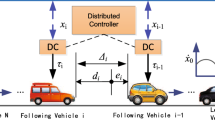Abstract
In this paper one methodology to solve the goal position assignment (GPA) problem is developed, this is, to assign the corresponding goal position (desired position) for a group of vehicles, knowing the initial positions and the established formation shape. By using this GPA methodology, it can be guaranteed that the formation will be reached in a minimum period of time and with lower collision risk compared with the other possible combinations of pairs “vehicles-goal position”. Hungarian algorithm was used as combinatorial optimization algorithm, which requires a cost matrix, therefore it is shown the way to compute the cost matrix to obtain the best GPA. In order to show the optimal behavior of the proposed cost matrix, three approaches of cost matrix were evaluated in simulations of quad-rotor formations. Also, the optimal behavior of the proposed GPA is proved with numerical values of some defined parameters to determine optimal performance. The formation control was based on potential functions, while the control law for each vehicle was based on nested saturation.
Similar content being viewed by others
Explore related subjects
Discover the latest articles, news and stories from top researchers in related subjects.References
Ahsun, U., Miller, D.W.: Dynamics and control of electromagnetic satellite formations. In: Proceedings of the 2006 American Control Conference, pp. 1730–1735 (2006)
Alsuwaiyel, M.H.: Algorithms: Design Techniques and Analys (Lecture Notes Series on Computing). World Scientific (1999)
Bai, C., Duan, H., Li, C., Zhang, Y.: Dynamic multi-uavs formation reconfiguration based on hybrid diversity-pso and time optimal control. In: IEEE Intelligent Vehicles Symposium (2009)
Barnes, L.E., Fields, M.A., Valavanis, K.P.: Swarm formation control utilizing elliptical surfaces and limiting functions. IEEE Trans. Syst. Man Cybern. 39(6), 1434–1445 (2009)
Castillo, P., Lozano, R., Dzul, A.: Stabilization of a mini rotorcraft having four rotors. IEEE Control Syst. Mag. 25(6), 45–55 (2005)
García, L., Dzul, A., Santibáñez, V., Llama, M.: Quad-rotors formation based on potential functions with obstacle avoidance. IET Control Theory Appl. 6(12), 1787–1802 (2012)
Hu, J., Prandini, M., Tomlin, C.: Interesting conjugate points in formation constrained optimal multi-agent coordination. In: 2005 American Control Conference (2005)
Lee, T., Leok, M., McClamroch, N.H.: A combinatorial optimal control problem for spacecraft formation reconfiguration. In: 46th IEEE Conference on Decision and Control (2007)
Lindhé, M., Ögren, P., Johansson, K.H.: Flocking with obstacle avoidance: a new distributed coordination algorithm based on voronoi partitions. In: 2005 IEEE International Conference on Robotics and Automation (2005)
Moon, S., Oh, E., Shim, D.H.: An integral framework of task assignment and path planning for multiple unmanned aerial vehicles in dynamic environments. J. Intell. Robot. Syst. 70(1–4), 303–313 (2013)
Reis, L.P., Lopes, R., Mota, L., Lau, N.: Playmaker: graphical definition of formations and setplays. In: 5th Iberian Conference on Information Systems and Technologies (2010)
Teel, A.R.: Global stabilization and restricted tracking for multiple integrators with bounded controls. Syst. Control Lett. 18(3), 165–171 (1992)
Walls, J., Howard, A., Homaifar, A., Kimiaghalam, B.: A generalized framework for autonomous formation reconfiguration of multiple spacecraft. In: 2005 IEEE Aerospace Conference, pp. 397–406 (2005)
Author information
Authors and Affiliations
Corresponding author
Rights and permissions
About this article
Cite this article
García-Delgado, L., Gómez-Fuentes, R., García-Juárez, A. et al. An Approach for Optimal Goal Position Assignment in Vehicle Formations. J Intell Robot Syst 73, 665–677 (2014). https://doi.org/10.1007/s10846-013-9932-5
Received:
Accepted:
Published:
Issue Date:
DOI: https://doi.org/10.1007/s10846-013-9932-5




